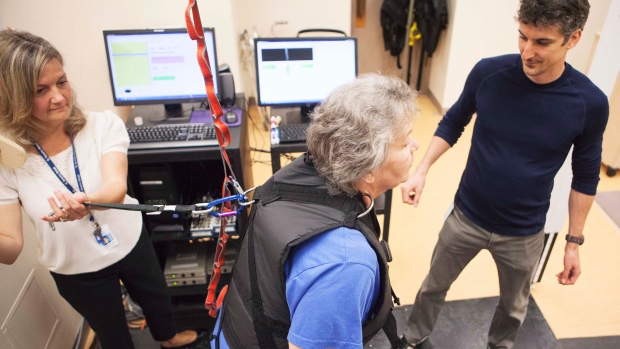Impaired Reactive Stepping in Stroke
Original Editor - Gayatri Jadav Upadhyay
Top Contributors - Ajay Upadhyay, Kim Jackson, Lucinda hampton, Gayatri Jadav Upadhyay, Redisha Jakibanjar, Evan Thomas, WikiSysop, Fasuba Ayobami, Claire Knott, Dinu Dixon and Scott Buxton
Introduction
[edit | edit source]
Postural control is required not only for proper body position in space, but is the basis on which movements are organized and executed either via anticipatory or reactive mechanisms. First, the antigravity function of posture provides the mechanical support necessary for the upright position. Second, balance needs to be maintained during movement execution. Third, posture serves as a reference frame for organizing body and limb movements.
Soon after hospital discharge the individuals with stroke are at increased risk for falls. The ability to react to a balance perturbation is critical to maintain balance and prevent falls. Impaired reactive stepping is a prevalent problem for ambulatory patients with stroke preparing for discharge. Its important to test the capacity to safeguard from fall induced by perturbation and stepping reactions may be important to identify those at risk for falls and to direct appropriate intervention strategies.
Knowledge of the locations of the limbs on the trunk and the head on the trunk is essential for making the correct transformations. To achieve the dual goals of dynamic stability and appropriate orientation during movement, both anticipatory and reactive mechanisms are utilized (Horak et al. 1997; Horak and Macpherson 1996; Massion 1992, 1998; Massion et al. 2004; Shumway-Cook and Woollacott 2001).
Mechanism
[edit | edit source]
Compared to young individuals, elderly subjects more often rely on stepping strategies as opposed to ankle or hip strategies to recover balance following a postural perturbation (Jensen et al. 2001; Maki et al. 2000; McIlroy and Maki 1996). So the ability to initiate a quick and efficient step is a critical factor for postural control in this population.
Stroke patients especially the elderly group demonstrates impaired anticipatory postural adjustments, delays in timing, an inability or unwillingness to initiate a step with the paretic limb, and the use of multi-step responses or the need for assistance to regain stability.
Clinical Assessment[edit | edit source]
Reactive postural control mechanisms govern the fast, feedback-driven corrections that appropriately redirect foot placement when necessary.
Reactive balance control is less frequently assessed. Reactive stepping can be evaluated by using a "lean-and-release" balance perturbation method. Patients need to wear a safety harness attached to an overhead support, and a physical therapist supervises to ensure safety.
Recent Related Research (from Pubmed)[edit | edit source]
Failed to load RSS feed from http://www.ncbi.nlm.nih.gov/entrez/eutils/erss.cgi?rss_guid=1TCb4A3LOGbUsLDKj9LC-7h9m6EdObKrUAR-yi3mLHHopXyQLr|charset=UTF-8|short|max=10: Error parsing XML for RSS
References[edit | edit source]
References will automatically be added here, see adding references tutorial.







